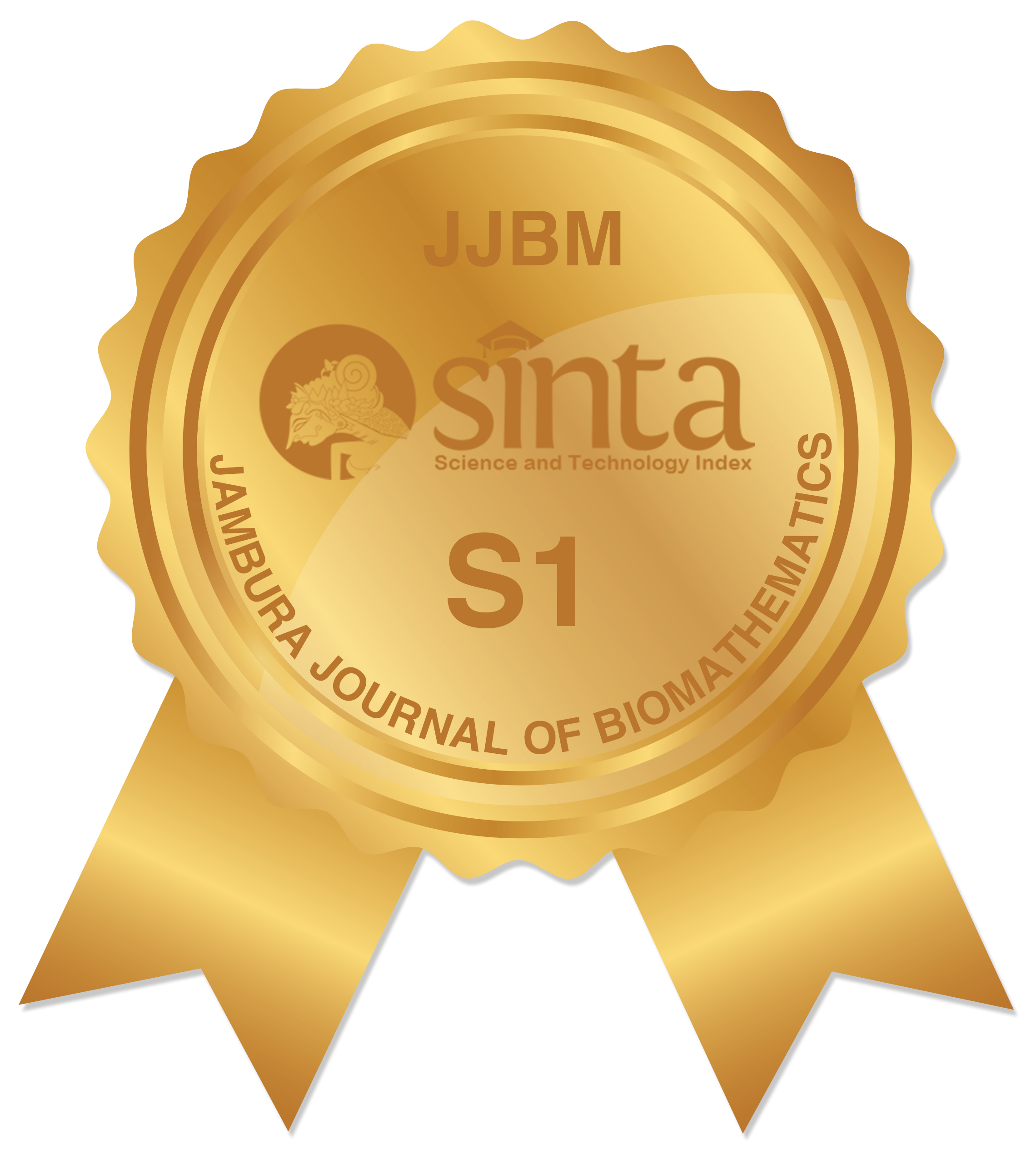Comparison of Optimal Control Effect from Fungicides and Pseudomonas Fluorescens on Downy Mildew in Corn
Abstract
Keywords
Full Text:
PDFReferences
M. E. M. Satmalawati and A. Rusae, "Identifikasi cendawan patogen pada penyimpanan jagung sesuai kearifan lokal masyarakatdi Kabupaten Timor Tengah Utaradalam perspektif ketahanan pangan" PARTNER, vol. 22, no. 1, pp. 406-416, 2017. DOI:10.35726/jp.v22i1.235
M. Falo and Y. M. Fallo, "Kajian pendapatan agroindustri tortila di Kecamatan Insana Barat Kabupaten Timor Tengah Utara" AGRIMOR, vol. 1, no. 02, pp. 19-20, 2016. DOI:10.32938/ag.v1i02.99
A. Karbaju and A. N. Hutapea, "Analisis pendapatan usahatani jagung pada kelompok tani Oelbubuk di Desa Oeolo Kecamatan Musi Kabupaten Timor Tengah Utara" AGRIMOR, vol. 2, no. 04, pp. 63-64, 2017. DOI:10.32938/ag.v2i04.311
B. P. Statistik, "Produksi jagung menurut kabupaten/kota (ton) tahun 2019-2021" 2022, https://ntt.bps.go.id/indicator/53/1470/1/produksi-jagung-menurut-kabupaten-kota.html, Accesed on 28 November 2023.
M. H. Nahak and S. J. Kune, "Analisis pendapatan usahatani jagung di Desa Bannae Kecamatan Insana Barat Kabupaten Timor Tengah Utara" AGRIMOR, vol. 2, no. 04, pp. 55-56, 2017. DOI:10.32938/ag.v2i04.174
H. M. Ridwan, M. Nurdin, and S. R. Dirmawati, "Pengaruh paenibacillus polymyxa dan pseudomonas fluorescens dalam molase terhadap keterjadian penyakit bulai (Peronosclerospora Maydis L.) pada tanaman jagung manis" Jurnal Agrotek Tropika, vol. 3, no. 1, 2015. DOI:10.23960/jat.v3i1.1990
M. A. Ulhaq and R. Masnilah, "Pengaruh penggunaan beberapa varietas dan aplikasi pseudomonas fluorescens untuk mengendalikan penyakit bulai (Peronosclerospora Maydis) pada tanaman jagung (Zea Mays L.)" Jurnal pengendalian hayati, vol. 2, no. 1, pp. 1-9, 2019. DOI:10.19184/jph.v2i1.17131
N. Anggriani et al., "Mathematical model for plant disease dynamics with curative and preventive treatments" AIP Conf. Proc., vol. 2043, no. 1., pp. 020016, 2018. DOI:10.1063/1.5080035
L. J. Allen et al., "Modelling vector transmission and epidemiology of co-infecting plant viruses" Viruses, vol. 11, no. 12, pp. 1153, 2019. DOI:10.3390/v11121153
R. Amelia et al., "Optimal control for the use of botanical fungicides in the spread of plant diseases" Journal of physics: conference series, vol. 1315, no. 1, pp. 012054, 2019. DOI:10.1088/1742-6596/1315/1/012054
R. Gallet, Y. Michalakis, and S. Blanc, "Vector-transmission of plant viruses and constraints imposed by virus-vector interactions" Current opinion in virology, vol. 33, pp. 144-150, 2018. DOI:10.1016/j.coviro.2018.08.005
S. Saudah, "Model matematika penyebaran penyakit pada daun jagung" Thesis, Universitas Lambung Mangkurat (ULM), 2022.
K. M. Putri et al., "Analisis dan kontrol optimal model matematika penyebaran penyakit daun pada tanaman jagung karena patogen" Ph.D. dissertation, Universitas Airlangga, 2018.
A. S. Rahmani, N. Anggriani, and A. K. Supriatna, "Kontrol optimal menggunakan a. aleyrodhis penyebaran penyakit virus kuning pada tanaman terong" Jurnal Matematika Integratif, vol. 19, no. 1, pp. 77-87, 2023. DOI:10.24198/jmi.v19.n1.44661.77-87
M. Rois, F. Fatmawati, and C. Alfiniyah, "Two isolation treatments on the COVID-19 model and optimal control with public education," Jambura Journal of Biomathematics (JJBM), vol. 4, no. 1, pp. 88-94, 2023. DOI:10.34312/jjbm.v4i1.19963
R. Amelia et al., "Stability analysis for yellow virus disease mathematical model of red chili plants" Journal of Physics: Conference Series, vol. 1722, no. 1, pp. 012043, 2021. DOI:10.1088/1742-6596/1722/1/012043
R. Amelia et al., "Dynamic analysis of mathematical model of the spread of yellow virus in red chili plants through insect vectors with logistical functions" AIP Conference Proceedings, vol. 2264, no. 1, 2020. DOI:10.1063/5.0023572
D. G. Ludji, P. Sianturi, and E. Nugrahani, "Dynamical system of the mathematical model for tuberculosis with vaccination" ComTech: Computer, Mathematics and Engineering Applications, vol. 10, no. 2, pp. 59-66, 2019. DOI:10.21512/comtech.v10i2.5686
A. Murwayi, T. Onyango, and B. Owour, "Mathematical analysis of plant disease dispersion model that incorporates wind strength and insect vector at equilibrium" British Journal of Mathematics & Computer Science, vol. 22, no. 5, pp. 1-17, 2017. DOI:10.9734/BJMCS/2017/33991
Firmansyah, and Y. M. Rangkuti, "Sensitivity Analysis and Optimal Control of Covid 19 Model," Jambura Journal of Biomathematics (JJBM), vol. 4, no. 1, pp. 95-102, 2023. DOI:10.34312/jjbm.v4i1.19025
H. T. Alemneh, A. S. Kassa, and A. A. Godana, "An optimal control model with cost effectiveness analysis of maize streak virus disease in maize plant" Infectious Disease Modelling, vol. 6, pp. 169-182, 2021. DOI:10.1016/j.idm.2020.12.001
A. U. Samsir, S. Toaha, and K. Kasbawati, "Optimal control of a mathematical model of smoking with temporary quitters and permanent quitters" Jurnal Matematika, Statistika dan Komputasi, vol. 18, no. 1, pp. 42-54, 2021. DOI:10.20956/j.v18i1.13974
N. Anggriani et al., "Optimal control of plant disease model with roguing, replanting, curative, and preventive treatment" Journal of physics: conference series, vol. 1657, no. 1, pp. 012050, 2020. DOI:10.1088/1742-6596/1657/1/012050
K. Amara et al., "Model perkembangan penyakit bulai pada berbagai varietas di Kabupaten Mojokerto" Plumula: Berkala Ilmiah Agroteknologi, vol. 8, no. 1, pp. 9-22, 2020. DOI:10.33005/plumula.v8i1.85
A. Rachmad, M. Fuad, and E. M. S. Rochman, "Convolutional neural network-based classification model of corn leaf disease" Mathematical Modelling of Engineering Problems, vol. 10, no. 2, 2023. DOI:10.18280/mmep.100220
DOI: https://doi.org/10.37905/jjbm.v5i1.23153
Copyright (c) 2024 Dian Grace Ludji, Roberta Uron Hurit, Siprianus Septian Manek, Meksianis Z Ndii

This work is licensed under a Creative Commons Attribution-NonCommercial 4.0 International License.
Jambura Journal of Biomathematics (JJBM) has been indexed by:
EDITORIAL OFFICE OF JAMBURA JOURNAL OF BIOMATHEMATICS |
 | Department of Mathematics, Faculty of Mathematics and Natural Science, Universitas Negeri Gorontalo Jl. Prof. Dr. Ing. B. J. Habibie, Moutong, Tilongkabila, Kabupaten Bone Bolango 96554, Gorontalo, Indonesia |
 | Email: [email protected] |
 | +6281356190818 (WA Only) |
 | Jambura Journal of Biomathematics (JJBM) by Department of Mathematics Universitas Negeri Gorontalo is licensed under a Creative Commons Attribution-NonCommercial 4.0 International License. Powered by Public Knowledge Project OJS. |
















